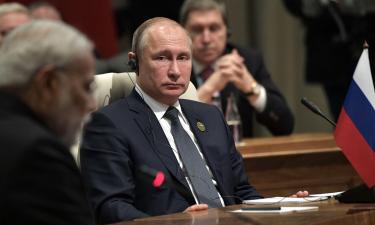US Missile Shield Sparks Space Arms Race Danger
Major-General Vladimir Slipchenko is a leading Russian defence expert. In his view, America's missile defence system is an attempt to establish military superiority in space using new principles of warfare. In an interview with this RIA Novosti analyst Slipchenko noted that "by 2010 the total number of precision-guided weapons in the arsenals of the most developed countries may reach 30,000 to 50,000 units, and after 2020 -- 70,000 to 90,000. The accent on the massive use of these weapons suggests that their designated purpose is not deterrence, but large-scale combat operations".
On September 12, a regular session of the UN conference on disarmament is due to complete its work in Geneva. General Slipchenko's opinion reflects Russia's position, which is to prevent the militarisation of outer space. And this position has been made clear in an official statement issued by the Foreign Ministry. Russia supports a proposal for a UN moratorium on the deployment of weapons in space and "is ready to assume such an obligation right away if the leading space powers join this moratorium".
But why is the disarmament process now related to space?
To begin with, the late 1990s brought with them a new strategic concept of warfare involving the large-scale use of precision-guided weapons. Extensive satellite networks are needed for them to be used effectively. Secondly, the United States, regardless of opposition, is deploying a global strategic missile defence shield. Objectively, the defence doctrines of the leading space powers, Russia and the US, will now focus on the militarisation of space. Unless appropriate international obligations are assumed, a runaway buildup of military space capabilities and the further militarisation of space will be inevitable.
Ever since man began to travel to the stars, military interests have been a paramount factor in exploration in this sphere. Since the mid-1960s, individual spacecraft and whole orbital formations have been developed and are currently widely exploited, the latter of which might tentatively be described as general-purpose military space systems.
Such systems are designed to give warnings about missile attacks, carry out observation and reconnaissance, ensure communications and help with navigation and meteorological studies. Although military-orientated, they are not weapons, since they are not intended to engage hostile targets and do not pose an offensive threat in or from space.
The space-based observation and intelligence-gathering craft bear the brunt of monitoring arms limitations agreements and troop and materiel movements.
Early warning spacecraft conduct global monitoring of missile launches and provide the leaders of nuclear states with the necessary information to make a balanced analysis of a situation and formulate an appropriate response.
Communications, navigation and weather spacecraft used by the armed forces in effect guarantee thesecurity of international transport and help avert dangerous situations at sea and in the air.
Thus, as Major-General Yevgeny Buzhinsky, deputy head of the Russian Defence Ministry's international agreements department, told a Moscow conference on strategic stability in May 2003 "one can state that the normal functioning of general-purpose military space systems on the whole helps to maintain strategic stability and international security".
But with the advent of entirely new types of precision-guided weapons, the status of general-purpose military satellite systems has been radically altered. High precision fire and guidance are generally ensured by formations of navigation, reconnaissance and weather satellites.
Consequently, rather than being individual units, these spacecraft turn into components of a weapons system called precision-guided weapons. In that way, precision-guided arsenals, if built up, will rapidly increase the number of military satellite formations, which are essentially elements of these weapons. In this context, the task today is to work out, within the norms of international law, a new approach to the limitation and control of general-purpose military satellite systems.
On the other hand, orbiting space weapons, i.e., means designed to hit enemy targets from space, should be banned from the outset. In the opposite scenario, the entire existing structure of understandings on strategic arms limitations will be eroded and a fresh impulse will be given to the arms race, raising it to a qualitatively advanced level.
Today this menace is very real, as Washington plans to work on a global missile defence system. "Global" is the important word here. A special memorandum of the US administration of May 21, 2003, explicitly states: the system we are developing must protect United States territory, our armed forces and those of our allies. In other words, half the Earth, since American troops are deployed in 120 countries across the globe. Naturally, such a large-scale objective cannot be met with conventional means, such as ground-based interceptors.
To believe a report issued by the RAND research corporation about a year ago on the Pentagon's orders, a missile defence system, to be effective, must employ orbital directed-energy weapons - mega-watt lasers, beam and kinetic weapons. These kinds of weapons are capable within a short interval of time of engaging both ground- and space-based targets.
The United States is almost certain to enjoy the lead in their development. But there will be only one outcome. In addition to the US and Russia, there are other countries with serious space programmes, such as France, China, Japan and India. The testing and deployment of weapons in space by a large number of countries may very well increase the probability of a global armed conflict that will be hard to avert.
Andrei Kislyakov, RIAN
Subscribe to Pravda.Ru Telegram channel, Facebook, RSS!





